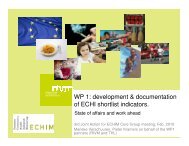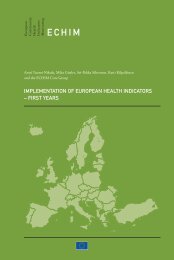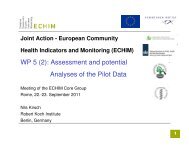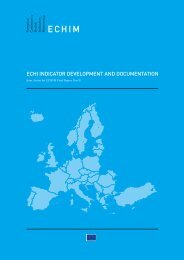INDICATORS
ECHIM Final Report
ECHIM Final Report
You also want an ePaper? Increase the reach of your titles
YUMPU automatically turns print PDFs into web optimized ePapers that Google loves.
Answer categories: Yes, with no difficulty / With some difficulty / With a lot of difficulty /<br />
Not at all.<br />
In the calculation of the indicator, the questions on the use of glasses/contact lenses (PL1)<br />
and of a hearing aid (PL4) are not considered. People are considered as<br />
a) not limited if the responses for all the remaining questions is always “Yes, with not<br />
difficulty”,<br />
b) moderately limited in case the response of at least one question is “Yes, with some<br />
difficulty” (and for none of the questions the response is “With a lot of difficulty” or “not at<br />
all”).<br />
c) severely limited if the response of at least one question is “With a lot of difficulty” or “Not<br />
at all”.<br />
Notes: The analysis will be limited to the age group 15+; it is the usual age category proposed<br />
in the framework of the European Health Interview Survey (EHIS). Also calculated for age<br />
groups 65+.<br />
The aim of the questions is to measure long-term (chronic) limitations, temporary<br />
limitations are not taken into account. Physical and/or sensory functional limitations are<br />
measured through reference to some actions/situations (walking 500 meters, carry shopping<br />
bags, seeing newspaper print, etc.). These actions/situations are only there to help to assess<br />
the level of functioning and should not be taken literally. Since it is possible that respondents<br />
are not obliged to do the listed actions/are not confronted with the listed situations, the<br />
functional limitation is measured in terms of capacity to undertake the task, rather than the<br />
performance.<br />
In the questions, it is stressed that the capacity to undertake the task without any aid should<br />
be estimated (to be sure that the limitation is not due to financial restrictions). Yet, for the<br />
sensory functional limitations (seeing and hearing), the capacities are estimated with the<br />
normal use of aids (glasses or contact lenses, hearing aid).<br />
37. GENERAL MUSCULOSKELETAL PAIN<br />
Definition: Prevalence of general musculoskeletal pain, measured by means of health<br />
interview survey using representative population sample.<br />
Calculation: Topic needs further developing.<br />
Project musculoskeletal disorders recommendation: 1. During the last week, have you had<br />
any pain affecting your muscles, joints, neck or back which has occurred on most days and<br />
which has affected your ability to carry out the activities of daily living? If Yes, please tick<br />
the region(s) in the grid (column a). 2. Has this pain (or pains) lasted for 3 months or more?<br />
If Yes, please tick the region(s) in the grid (column b). Head – Neck – Shoulder(s) – Upper<br />
back – Elbows – Wrist(s) / hand(s) – Low back – Hip(s) / thigh(s) – Knee(s) – Ankles / foot/<br />
feet.<br />
Notes: Data on general musculoskeletal pain is not currently available from international<br />
databases. No instruments for monitoring musculoskeletal problems in HISs have been<br />
properly validated in an international setting. For example SF-36 includes pain in general,<br />
not musculoskeletal pain. Also EHIS has no question on musculoskeletal pain, just a general<br />
question on any physical pain or discomfort. Some HISs include specific questions on<br />
diagnosis, as “have a doctor ever told you that you have osteoporosis?”, but such questions<br />
are not considered relevant for monitoring unspecified musculoskeletal problems.<br />
105










